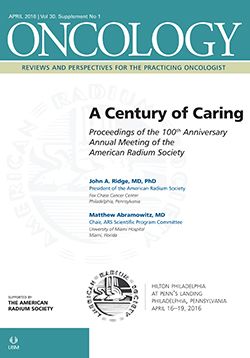(P026) The “Decay” of Brachytherapy in Tumors of the Oral Cavity: A Population-Based Patterns-of-Care and Outcomes Analysis From 1973 to 2012
The use of brachytherapy improves survival in oral cavity tumors treated with definitive radiation therapy.
Andrew Orton, MD, Dustin Boothe, MD, Meng Gan, MD, Ying Hitchcock, MD, Shane Lloyd, MD; University of Utah
PURPOSE: We aimed to evaluate changes in the use of brachytherapy (BT) for tumors of the oral cavity treated with primary radiation therapy (RT) over the last 40 years and determine if the use of a BT boost was associated with a survival benefit.
MATERIALS AND METHODS: We queried the Surveillance, Epidemiology, and End Results (SEER) database for patients who received definitive RT for squamous cell carcinoma of the oral cavity between 1973 and 2012. Trends in BT utilization were analyzed. Logistic regression was used to determine characteristics that predicted for receipt of BT. Propensity score matching was used to balance the study groups. Cox proportional hazards regression estimated the effect of receipt of BT on survival. Sensitivity analysis was then done to estimate the robustness of the analysis to unmeasured confounders.
RESULTS: A total of 4,131 patients with squamous cell carcinoma of the oral cavity who received definitive RT were identified. The rates of BT usage for all oral cavity subsites decreased by 0.7% per year over the study period (95% CI, −0.8% to −0.5%) and ranged from 32.6% to 1.2%. Multivariate logistic regression revealed that patients who were aged > 65 years (adjusted odds ratio [aOR], 0.57 [95% CI, 0.45–0.71]), male (aOR, 0.67 [95% CI, 0.67–0.99]), and black (aOR, 0.38 [95% CI, 0.26–0.54]) were less likely to receive BT. Use of BT was also less likely in floor of mouth (aOR, 0.70 [95% CI, 0.53–0.96]) and lip (aOR, 0.15 [95% CI, 0.09–0.25]) tumors or in disease that had spread to regional nodes (aOR, 0.56 [95% CI, 0.46–0.69]). Shared-frailty Cox regression revealed decreased risk of death among patients who received BT (hazard ratio [HR], 0.72 [95% CI, 0.64–0.82]). On sensitivity analysis, the benefit of BT was robust in the face of unmeasured confounders.
CONCLUSIONS: The use of BT improves survival in oral cavity tumors treated with definitive RT.
Proceedings of the 98th Annual Meeting of the American Radium Society - americanradiumsociety.org

Targeted Therapy First Strategy Reduces Need for Chemotherapy in Newly Diagnosed LBCL
December 7th 2025Lenalidomide, tafasitamab, rituximab, and acalabrutinib alone may allow 57% of patients with newly diagnosed LBCL to receive less than the standard number of chemotherapy cycles without compromising curative potential.